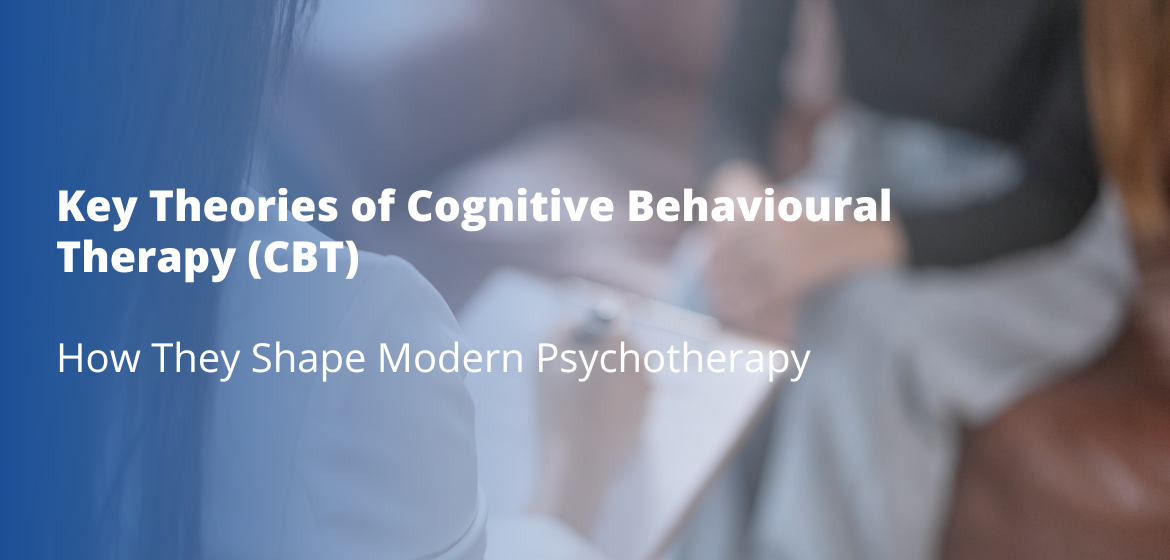
Key Theories of Cognitive Behavioural Therapy (CBT)
Cognitive Behavioural Therapy (CBT) is one of the most widely used and evidence-based approaches in modern psychotherapy. It is built on the understanding that our thoughts, emotions, and behaviours are interconnected, meaning that by changing one, we can influence others. CBT draws from several psychological theories that help explain how negative thought patterns develop and how they can be modified for better mental well-being. Below, we explore the key theories that form the foundation of CBT and their impact on therapeutic practices.
Beck’s Cognitive Theory: How Our Thoughts Shape Our Reality
One of the most influential theories in CBT is Beck’s Cognitive Model, developed by psychiatrist Aaron Beck in the 1960s. Beck observed that individuals struggling with anxiety and depression often experienced automatic negative thoughts—spontaneous, unconscious thoughts that reinforced feelings of distress. These thoughts are shaped by cognitive distortions, such as:
- Catastrophising (“Something terrible will happen”)
- Over-generalisation (“I always fail”)
- All-or-nothing thinking (“If I’m not perfect, I’m a failure”)
At the core of Beck’s theory is the concept of schemas, which are deep-rooted beliefs formed through life experiences. If someone develops a negative schema—such as believing they are unworthy or incapable—it can subconsciously influence how they interpret new situations, often reinforcing negative thought patterns. In CBT, therapists help individuals recognise and challenge these distortions, replacing them with more balanced, rational perspectives.
Ellis’ Rational Emotive Behaviour Therapy (REBT): Rewiring Irrational Beliefs
Developed by Albert Ellis, Rational Emotive Behaviour Therapy (REBT) is another cornerstone of CBT. Ellis argued that emotional distress is not caused by external events, but by how we interpret them. He introduced the ABC Model to explain this process:
- A (Activating Event): A situation or trigger.
- B (Belief): The interpretation of the event, which can be rational or irrational.
- C (Consequence): The emotional and behavioural response resulting from the belief.
For example, if someone fails a job interview (A) and believes “I’ll never be successful” (B), they might experience feelings of hopelessness and avoid applying for new jobs (C). REBT teaches clients to dispute (D) irrational beliefs and replace them with effective (E) new thinking that fosters healthier emotions and behaviours. This approach is particularly powerful in helping individuals break free from self-defeating thought patterns.
Meichenbaum’s Cognitive-Behavioural Modification (CBM): Changing Self-Talk to Change Behaviour
Donald Meichenbaum introduced Cognitive-Behavioural Modification (CBM), focusing on the role of self-talk in shaping emotions and actions. He proposed that negative self-statements contribute to stress, anxiety, and maladaptive behaviours. In therapy, clients learn to become aware of their self-talk, challenge harmful thoughts, and replace them with more constructive ones.
CBM also incorporates graduated exposure, where individuals gradually confront anxiety-provoking situations while using positive coping strategies. This approach is commonly used in anxiety and trauma therapy, helping individuals build resilience by retraining their inner dialogue.
Behavioural Learning Theories: How Conditioning Shapes Our Actions
CBT also integrates behavioural learning theories, particularly from Ivan Pavlov and B.F. Skinner. These theories explain how we develop habits, fears, and emotional responses through conditioning.
- Pavlov’s Classical Conditioning shows how we associate neutral stimuli with emotional responses (e.g., developing anxiety in social situations after a past negative experience).
- Skinner’s Operant Conditioning emphasises that reinforcement and punishment shape behaviour. For instance, if avoiding social situations reduces anxiety, avoidance becomes reinforced, making social anxiety worse over time.
CBT interventions, such as exposure therapy and behavioural activation, use these principles to help clients unlearn maladaptive behaviours and replace them with healthier coping mechanisms.
Bandura’s Social Learning Theory: The Power of Observational Learning
Psychologist Albert Bandura expanded on behavioural theories by introducing the idea that people learn through observation. His Social Learning Theory emphasises the role of modeling, imitation, and self-efficacy in behaviour change.
Bandura found that individuals are influenced by watching others—whether it’s parents, peers, or media figures. If someone grows up observing anxious or avoidant behaviours in their environment, they may unconsciously adopt similar patterns. Additionally, self-efficacy (the belief in one’s ability to overcome challenges) plays a crucial role in how people approach difficulties.
CBT uses Bandura’s principles to help clients build confidence in their ability to manage emotions and change behaviours by setting achievable goals and reinforcing positive change.
Third-Wave CBT: Mindfulness & Emotional Regulation
Modern CBT has evolved to include third-wave therapies, which integrate mindfulness and emotional acceptance alongside traditional cognitive techniques.
These include:
- Mindfulness-Based Cognitive Therapy (MBCT) – Helps prevent relapse in depression by increasing awareness of negative thought patterns without reacting to them.
- Acceptance and Commitment Therapy (ACT) – Encourages individuals to accept distressing thoughts instead of fighting them, focusing on taking meaningful action.
- Dialectical Behaviour Therapy (DBT) – Combines CBT with emotional regulation techniques, making it particularly effective for conditions like borderline personality disorder (BPD).
These approaches recognise that not all negative thoughts need to be changed—sometimes, simply observing and accepting them without judgment can reduce their impact.
How These Theories Shape Cognitive Behavioural Therapy Today
Cognitive Behavioural Therapy is a powerful therapeutic approach because it is rooted in scientific principles and continues to evolve with new research. From Beck’s cognitive restructuring to Bandura’s self-efficacy theory and third-wave mindfulness practices, these foundational theories provide a roadmap for understanding and transforming thought patterns.
By identifying negative thinking habits, challenging irrational beliefs, and implementing behavioural changes, CBT empowers individuals to take control of their mental well-being. Whether treating anxiety, depression, trauma, or stress, these theories guide therapists and clients in developing practical strategies for lasting change.
Interested in learning more about the principles and practice of Cognitive Behavioural Therapy? Take the next step in your career with our M.A. in Counselling & Psychotherapy (Cognitive Behavioural Modalities). Gain in-depth knowledge, hands-on experience, and a pathway to professional accreditation.























